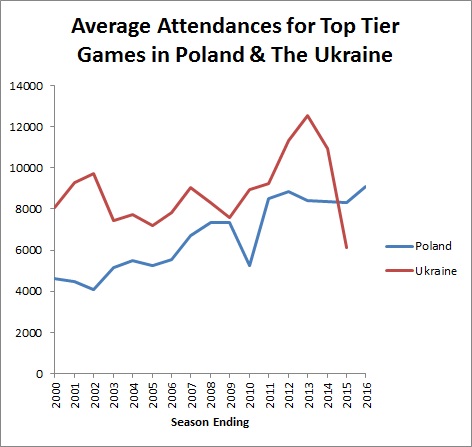Back in 2012 ‘Legacy’ was a word which was used quite a lot in connection with the London Olympics. There was a clear desire that once the main show packed up and left town that there would be lasting change, that in the long term, decades on, there would be more to show than a handful of underused, decaying stadia fit only for the bulldozer – that there would be instead a revitalisation of areas, of sports, and of lives.
Aside from the London games there was also another major sporting event in 2012 – The European Football Championships, jointly hosted by Poland and the Ukraine – and as we sit on the eve of the latest 2016 edition to take place in France it is perhaps a pertinent time to see what legacy, if any, Euro 2012 left for its host nations.
One of the key investments made for any major sporting event, whether it’s an Olympics, or Football Championships is the cost of the physical infrastructure needed to stage the event – the stadia, the transport connections, hotels and so on. Euro 2012 involved the construction of no fewer than five new stadia and the extensive renovation of a further three. The new stadia were constructed in Warsaw, Wroclaw, Gdansk, Donetsk, and Lviv.
One discernible legacy of such bricks and mortar investment can be seen in improved attendances for those clubs based at the stadia as enhanced capacity and improved facilities attract more spectators to games. Using data from the European Football Statistics Website it is possible to plot attendance trends in Poland and the Ukraine both before and after the Euros.
It’s possible to see in both host countries a discernible rise in average attendances around Euro 2012. In the 2012/13 season attendances for top flight games in Poland and the Ukraine averaged at 8,409 and 12,547 respectively. These were up from 5,247 in Poland and 8,943 in The Ukraine for the 2009/10 season.
What happened next of course was to cause the Ukrainian average to plummet. This was down to the political situation in the Ukraine, one consequence of which was the exiling of one of the Ukraine’s biggest clubs Shakhtar Donetsk. In 2014 the club literally had to get out of town, leaving behind the sparkling Donbass arena, constructed in 2009. Whilst the club, backed by a wealthy owner, has continued to prosper on the pitch – reaching the semi-finals of this year’s Europa League – in the stands the dislocation from its fan base is obvious in attendance figures; Playing home games some 780 miles away in Lviv attendances have slid from 33,226 in the 13/14 season to 8,833 in the 14/15 season.
Meanwhile in Poland a wave of stadia renewal has been continuing post Euro 2012. The Ernest Pohl Stadium, home of Gornik Zabrze, the Bialystok City Stadium, home of Jagiellonia Bialystok and the Stadion Widzewa, home of Widzew Lodz are amongst grounds which have recently, or are currently undergoing major reconstruction, or complete rebuilding. This replacing of outdated facilities has unsurprisingly led to attendances continuing to rise, ensuring that in Poland at least the legacy of 2012 continues to be felt.


What was the crowd trouble like in 2012? I don’t remember much – it’s not looking too good for World Cup in Russia 2018 at the moment! >
I think there were some clashes, also involving Russian fans. I certainly wouldn’t want to be part of the 2018 organising committee.